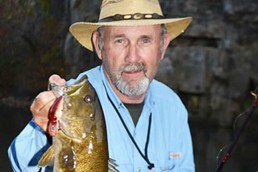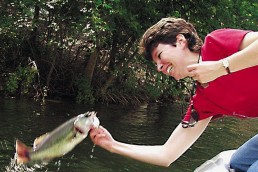Management and Memories: Floating Ozark Streams for Smallies
Smallmouth bass are the kings of Ozark streams. Beautifully colored bronze bodies barred with sharp black blotches, they are the dream of every angler who ever hooked into one of these powerful fish.
“Smallmouths are the epitome of the Ozarks,” said Matt Weir, the president of the Smallmouth Alliance of Missouri. “The free-flowing streams of the Missouri Ozarks are national treasures and the smallmouth bass is part of the loot. The smallmouths are as wild as the streams they inhabit.”
These bass of our Ozark streams are indeed a treasure, attracting anglers from far and wide to do battle with the hard-fighting fish. John Barton, from Illinois, makes an annual pilgrimage to the Jacks Fork River with several friends.
“We love the crystal clear waters of the Jacks Fork,” Barton said. “The river holds us spellbound for the entire three-day float we do each year. It is about a five-hour drive for us, but we don’t mind. There are no rivers in Illinois that compare to this. And the smallmouth bass fishing is superb, adding a bonus to every trip.”
Missouri now has 10 streams with special smallmouth bass management areas. Designation of these areas was a long time in the making.
“Missouri has a long history of black bass management on Ozark streams,” said Jen Girondo, a fisheries management biologist with the Missouri Department of Conservation. “Early studies concentrated on finding how many fish Missouri streams could produce, how fast they grew and how to best improve smallmouth fishing.”
These studies led to a closure of smallmouth bass fishing in 1965, a 12-inch minimum length limit in 1974,six-per-day limit regulations and an understanding that stocking would not improve stream bass fishing. The conservation department began an aggressive stream access program to provide public access to smallmouth streams.
Habitat improvement projects began in the 1980s, and in 1991 the first Stream Black Bass Special Management Areas were established, with the intention of improving the numbers and sizes of smallmouth bass through special regulations.
The management areas proved to be successful, leading to a statewide effort to identify, study and improve Missouri’s best black bass streams. Additionally, biologists studied Kentucky bass and smallmouth interactions, which led to the removal of protection for Kentucky bass in many streams.
Missouri now has almost 300 miles of streams with special management regulations and hundreds more miles of streams with statewide regulations consisting of 12-inch minimum length limit and a daily limit of six.
Smallmouth management has greatly increased the size structure of smallmouth bass in Ozark streams, according to retired MDC fisheries biologist Spence Turner.
“Without exception, Missouri is at the forefront of the best smallmouth fishing in the nation,” he stated. “Even in streams still managed with the 12-inch, six-bass creel regulations, anglers release most smallmouths they catch, understanding that to produce or grow large smallmouths, small ones must be released to live and grow.”
Turner believes that smallmouth anglers are ahead of management agencies in realizing what it takes to produce the bass in our Ozark streams.
“This happened with largemouth bass management in our lakes and reservoirs as Bass Anglers Sportsman Society members became convinced harvesting small fish hurt the production of large ones,” he said.
With the bad publicity associated with B.A.S.S. tournaments and the large numbers of dead fish being weighed in, Ray Scott, the then-CEO of B.A.S.S., started live-release tournaments. The measure caught on and today almost all bass anglers release every bass they catch.
Management agencies caught on as well by realizing that catch-and-release was the future of bass fishing in lakes and reservoirs. Regulations were implemented to allow only a limited harvest of trophy-sized bass.
“The changes started here in Missouri and then rapidly spread to other states,” Turner pointed out. “Unfortunately, in Missouri Ozark streams, it is taking much longer to convince management agencies that the same approach to smallmouth management would work.”
The first real changes to smallmouth management policies in Missouri came in the 1990s. Those changes produced positive results, but many smallmouth anglers feel that further regulations need to be applied to more miles of streams to produce better smallmouth fishing over a larger area. Improved management policies for smallmouth bass have worked well in 300 miles of our streams. It stands to reason that many more miles of streams could benefit from new regulations as well.
The biggest problem smallmouth anglers face when coming to the Ozarks is not whether they can catch a decent smallmouth bass, but deciding which stream to float and fish.
The choices are good. However, even the best smallmouth fishermen I know have their favorite smallmouth streams. “The Big Piney is the best smallmouth stream I have ever fished,” said Dale Goff of Rolla, Missouri.
“I’m partial to the Huzzah and Meramec, explained Corey Cottrell of Steelville.
“The Gasconade produces some of the biggest smallmouth in the state,” bragged Will Rollins of Vienna.
“I catch my biggest smallmouth from the Current River,” said Ron Kruger of Ironton.
For my money, the Jacks Fork provides the best all-around smallmouth fishing. The scenery is worth the trip, but feisty smallies make it all the more memorable.
MWO
SHARE THIS POST
Did you enjoy this post?
You can be among the first to get the latest info on where to go, what to use and how to use it!
Bill Cooper
An inductee to the National Fresh Water Fishing Hall of Fame, Bill Cooper, from the Missouri Ozarks, has written over 4,000 articles on outdoor subjects. You can hear him on Wild at Heart Outdoor radio at espn1073.com.



